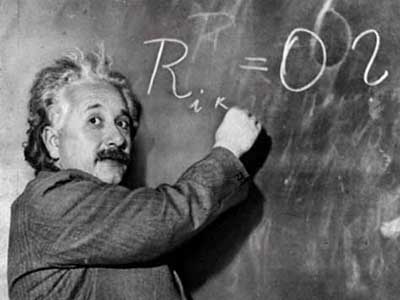A Century Later, Einstein Holds True
Anna Gruber |
February 19, 2016
Last week, scientists announced that they had detected and recorded the sound of two black holes colliding. According to physicists, this sound is the first concrete evidence of gravitational waves, something that Albert Einstein predicted nearly a century ago. This is not the first time that one of Einstein’s theories has been proven correct. In fact, one of the reasons that Einstein is still celebrated today is because nearly every prediction he made has been tested and verified. Aside from his prediction of gravitational waves, Einstein has two more well know theories that have been proven in recent years: the special theory of relativity, and the general theory of relativity.
In his special theory of relativity, Einstein came to the conclusion that time is not constant, nor is weight or mass, but energy and mass are equivalent This conclusion produced perhaps the most famous equation in science, E=mc2. This theory predicts that when objects move at a high speed, all of these attributes of the object become compressed, but the only thing that remains constant is the speed of light. The theory further states that as objects approach the speed of light they get shorter in the direction of travel, time passes more slowly, and their mass increases. Experimenters have been able to prove this by carrying extremely accurate atomic clocks on high-speed jets on flights which were calculated to travel at about a quarter of the speed of light. When scientists compared these clocks to the extremely accurate clocks they left at home, the traveling clock had indeed gone slower and lost time.

While the special theory of relativity changed how time and space were viewed, it still left Einstein with many questions, which he answered nearly a decade later in his general theory of relativity. In this theory Einstein suggests that gravity is not a force – as it was believed to be by Newton – but is instead the result of a curvature of the space-time continuum (the four dimensional paradigm he establish in his special theory of relativity). Einstein used a thought experiment to back his claims when they were published in 1915, but in 2011 scientists were finally able to produce concrete evidence that supported his claim. Using NASA’s Gravity Probe B project, scientists were able to compile evidence which proves that the Earth bends in space-time, and discovered that as the planet rotates it drags space time with it, which is also known as frame-dragging. These phenomena, while landmark discoveries, have relatively tiny effects. In the case of frame-dragging, space around Earth turns at a rate of merely 37 one-thousandths of a second every year because our planet pulls it round as it revolves – a rate predicted by Einstein.
So why do we, as a society, still care so much about Einstein? Well, apart for the groundbreaking theories that continue to change the way we view the universe, Einstein was known and applauded for his modesty. He never actively sought the spotlight, but was always willing to step into the public eye when he found it suited his causes. Another reason Einstein is so celebrated a century on is because he was unapologetic for his individuality. He embraced his uniqueness, which is often represented by his wild, untamed hair, in a time when such an attitude was largely frowned upon. In doing so he proved that people can come from anywhere, look however they want, and still make a huge impact on the world. We love Einstein because his image not only inspires academic greatness, but also empowers individuals to take pride in themselves and strive to make a difference in the world.